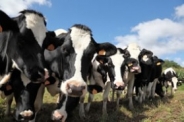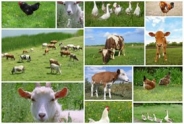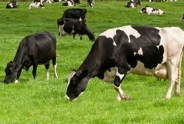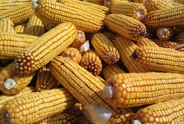Forages
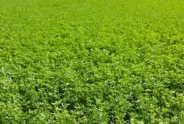 In western New York high yields of high quality forage are vital to the dairy and livestock industries. Feed-costs are often half of a farm's business expenses each year. This page contains resources and information to help farmers better manage silage, hay, and pastures.
In western New York high yields of high quality forage are vital to the dairy and livestock industries. Feed-costs are often half of a farm's business expenses each year. This page contains resources and information to help farmers better manage silage, hay, and pastures. Farm Financial Management Practices for Unfavorable Economic Conditions
Sound financial planning and control improve owner's abilities to manage their businesses during unfavorable economic conditions. Consider the current environment affected by the COVID-19 pandemic, and the lack of rain in many areas. Budgeting is a valuable farm financial management practice for these situations. Visit (Brandie, please insert link here) to learn more about budgeting and its value in managing your farm business.
Reducing the Risk of Compaction When Grazing Cover Crops
Nancy Glazier, Small Farms & Livestock Specialist
Northwest New York Dairy, Livestock & Field Crops

The benefits of cover crops have been known for many
years; one is remediating compaction.
Dairy Culture Coach September 2019
Libby Eiholzer, Bilingual Dairy
Northwest New York Dairy, Livestock & Field Crops
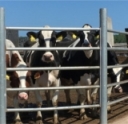
The latest issue of the Dairy Culture Coach includes the following topics:
- Improving Human Resource Management
- Silage Harvest Vocabulary
- The Importance of Corn
- La Importancia del Maíz
- Consulate Updates
Please feel free to contact Libby with questions, to subscribe to the newsletter, or to make suggestions for future content. geg24@cornell.edu or 607-793-4847.
Dairy Alert 9.24.19
Libby Eiholzer, Bilingual Dairy
Northwest New York Dairy, Livestock & Field Crops
Welcome to the new Dairy Alert!
While many of you receive our monthly newsletter, Ag Focus, we wanted a way to stay in touch during those in-between weeks when there is important news to share. In this issue:
Corn Silage Pre-Harvest Meetings
Pricing Corn Silage
Sexual Harassment Prevention: Comply by 10/9
Pricing Corn Silage -- Fall 2019
John Hanchar, Farm Business Management Specialist
Northwest New York Dairy, Livestock & Field Crops
- Analysis suggests corn silage price depends on corn silage quantities, alfalfa hay price, the price received by farmers for milk, and corn grain price.
- Analysis for NY suggests that estimated corn silage price is most sensitive to corn silage quantities, alfalfa hay price and corn grain price.
- Price estimates combined with understanding of relevant supply and demand factors from an individual farm business owner's perspective can aid decision making regarding corn silage price. Given recently available alfalfa hay and corn grain prices (May through July, 2019, and August 27, 2019, respectively), price analysis for NY suggests an estimated corn silage price of about $45 per ton. The Fall 2018 estimate was about $41 per ton.
Webinar for Dairy Producers will Cover New Dairy Margin Coverage Program
John Hanchar, Farm Business Management Specialist
Northwest New York Dairy, Livestock & Field Crops
The USDA/Farm Service Agency in New York is partnering with the NYS Crop Insurance Education Program to present a webinar for dairy producers.
Alfalfa Height Measurement updated weekely

Locations around the region are listed where we have measured alfalfa height (see spreadsheet). You can use the location and elevation as a guide to conditions that may be similar to your farm.
The 2019 hay crop season is shaping up to be similar to our 2018 harvest schedule. An alfalfa height of 9 inches or less is too low to be used by the equation we have which is why you see "Too Early." On May 2, 2018 the alfalfa averaged 7 inches tall and as of today, May 2, 2019, alfalfa is averaging 7 inches tall.
The table below indicates no grasses are ready to be cut today. The continued temperature fluctuations along with rain will influence how much growth we get in another week so stay tuned! Soil temperatures are ranging between 38 and 46 degrees in places.
It is important that you get first cutting off in a timely manner for quality purposes, so please communicate in advance with your team on how you are going to plant corn and successfully harvest 1st cutting. Additional fields to be added to next report.
Week 2, Updated May 9, 2019:
| County | Town | Road Name | Elevation | Alfalfa Height Inches | Predicted Grass % NDF | Predicted 50/50 Mix % NDF | Predicted Alfalfa % NDF | Predicted Date to Cut Grass | Predicted Date to Cut Mix | Predicted Date to Cut Alfalfa |
| Monroe | Scottsville | Cameron RD | 620 | 11 | 46.5 | 33.7 | 26.2 | 5/5/19 | 5/14/19 | 5/25/19 |
| Wyoming | Castile | Glen Iris RD | 1340 | 11 | 46.5 | 33.7 | 26.2 | 5/5/19 | 5/14/19 | 5/25/19 |
| Livingston | Geneseo | Lakeville-Groveland RD | 850 | 12 | 47.4 | 34.5 | 26.9 | 5/4/19 | 5/13/19 | 5/24/19 |
| Orleans | Medina | Seaman Rd | 525 | 7 | Too Early | Too Early | Too Early | Too Early | Too Early | Too Early |
| Orleans | Lyndonville | County line rd | 322 | 10 | 45.6 | 32.8 | 25.5 | 5/6/19 | 5/16/19 | 5/27/19 |
| Ontario | Hopewell | County rd 4 | 860 | 13 | 48.2 | 35.4 | 27.6 | 5/3/19 | 5/12/19 | 5/22/19 |
| Yates | Penn Yan | Field Lane 364 | 1000 | 12 | 47.4 | 34.5 | 26.9 | 5/4/19 | 5/13/19 | 5/24/19 |
Week 1, May 2, 2019
| County | Town | Road Name | Elevation | Alfalfa Height Inches | Predicted Grass % NDF | Predicted 50/50 Mix % NDF | Predicted Alfalfa % NDF | Predicted Date to Cut Grass | Predicted Date to Cut Mix | Predicted Date to Cut Alfalfa |
| Monroe | Scottsville | Wheatland Center RD | 620 | 7 | Too Early | Too Early | Too Early | Too Early | Too Early | Too Early |
| Wyoming | Castile | Glen Iris RD | 1340 | 7 | Too Early | Too Early | Too Early | Too Early | Too Early | Too Early |
| Livingston | Geneseo | Groveland RD | 850 | 7 | Too Early | Too Early | Too Early | Too Early | Too Early | Too Early |
| Livingston | Geneseo | Chandler RD | 870 | 7 | Too Early | Too Early | Too Early | Too Early | Too Early | Too Early |
| Ontario | Hopewell | Spangle Rd | 860 | 7 | Too Early | Too Early | Too Early | Too Early | Too Early | Too Early |
| Ontario | Hopewell | Spangle Rd | 740 | 7 | Too Early | Too Early | Too Early | Too Early | Too Early | Too Early |
| Seneca | Waterloo | Yellow Tavern Rd | 590 | 8 | Too Early | Too Early | Too Early | Too Early | Too Early | Too Early |
Winter Feeding Beef Cows
Nancy Glazier, Small Farms & Livestock Specialist
Northwest New York Dairy, Livestock & Field Crops
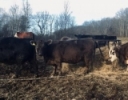
Winter is a challenging time to feed the beef herd. Mud, cold and snow or rain can stress your cows and increase their nutritional needs. How do you know if you are meeting the needs of your herd?
Financial Balancing Act Means Managing Risk is Essential
Joan Sinclair Petzen, Farm Business Management
Northwest New York Dairy, Livestock & Field Crops
The present long-term downturn in commodity prices brings with it increased financial pressure on farm operations. Alternatives for managing risk are continually evolving. For many in agriculture, and particularly dairy, self-insurance has been the go-to method of risk management. Two new tools, the USDA Market Facilitation Program (MFP) and Dairy Revenue Protection Insurance (DRP) are coming on line and a third, Rainfall Index - Pasture, Rangeland, and Forage (RI-PRF) merits serious consideration.
Pricing Corn Silage -- Fall 2018
John Hanchar, Farm Business Management Specialist
Northwest New York Dairy, Livestock & Field Crops

Summary
- Analysis suggests corn silage price depends on corn silage quantities, alfalfa hay price, the price received by farmers for milk, and corn grain price.
- Analysis for NY suggests that estimated corn silage price is most sensitive to corn silage quantities, alfalfa hay price and corn grain price.
- Price estimates combined with understanding of relevant supply and demand factors from an individual farm business owner's perspective can aid decision making regarding corn silage price. Given recently available alfalfa hay and corn grain prices (May through July, 2018, and August 14, 2018, respectively), price analysis for NY suggests an estimated corn silage price of about $41 per ton. The Fall 2017 estimate was about $54 per ton.
Crop Alert
Mike Stanyard, Field Crops & IPM Specialist
Northwest New York Dairy, Livestock & Field Crops

Timely observations, information, and control strategies for managing pests, fertility, and current conditions on northwestern NY farms.
Stockpiling Pastures
Nancy Glazier, Small Farms & Livestock Specialist
Northwest New York Dairy, Livestock & Field Crops

1st Cutting Forage Quality Update - May 18, 2018
Jodi Letham, Field Crops & Soils Specialist
Northwest New York Dairy, Livestock & Field Crops
This is the first week of monitoring 1st cutting for quality this year. Our procedure consists of using alfalfa height to predict Neutral Detergent Fiber (NDF) for alfalfa, alfalfa/grass mixed and grass stands. Alfalfa height has proven to be a reliable indicator of NDF values in the field.
The Meaning and Use of Feed Analysis

Beef Specialist Mike Baker explains the nutrient requirements for beef cattle and interpreting the forage analysis.
Know a Better Pasture
Nancy Glazier, Small Farms & Livestock Specialist
Northwest New York Dairy, Livestock & Field Crops

Pasture is a great way to feed your livestock during the growing season.
Meet the Specialist, Nancy Glazier

Meet Small Farms Specialist Nancy Glazier as she works with Peter Lehning and John Lehning, new beef producers.
1st Cutting Forage Quality Update
Jodi Letham, Field Crops & Soils Specialist
Northwest New York Dairy, Livestock & Field Crops
We are into the third week of monitoring 1st cutting for quality this year. Our procedure consists of using alfalfa height to predict Neutral Detergent Fiber (NDF) for alfalfa, alfalfa/grass mixed and grass stands. Alfalfa height has proven to be a reliable indicator of NDF values in the field.
Managing Spring Grass Growth and Selective Grazing

For most beef cattle farmers who are managing their pastures in a rotational grazing system two of the biggest spring challenges are the flush of rapid growth that will occur and selective grazing. OSU Wayne Co. extension educator Rory Lewandowski reviews some basic plant growth biology and grazing principles that may suggest some management strategies. Click here for the full article.
Forage Congress - Presentations
Nancy Glazier, Small Farms & Livestock Specialist
Northwest New York Dairy, Livestock & Field Crops

New to the NWNY Team's lineup this winter was Forage Congress at the Genesee River Restaurant and Reception Center in Mount Morris, NY.
This event covered timely topics recommended by the region's producers. The morning's session began with an overview of the cropping plan from the ground up, economics of high fiber digestibility, and new alfalfa varieties with quality grasses. The afternoon covered double cropping with winter triticale and options for properly storing silages.
Benefits and Costs of Entry Level Precision Agriculture Technologies
John Hanchar, Farm Business Management Specialist
Northwest New York Dairy, Livestock & Field Crops

Auto Section Control (ASC) is a precision agriculture technology designed to reduce double planting and other crop input usage in headlands. See the presentation by Erick Haas and John Hanchar at the 2017 Operations Managers Conference for benefits and costs, including results from partial budgeting and capital investment analysis.
New York State Corn Silage Hybrid Trials - 2016

Joe Lawrence with PRO-DAIRY has revitalized the corn silage variety trials. Here is the report.
Food for Thought: To Cover or Not To Cover Trucks
Joan Sinclair Petzen, Farm Business Management
Northwest New York Dairy, Livestock & Field Crops

The name of the forage harvest game for 2016 in drought stricken area is conservation of every ton of forage you can harvest. During harvest, time is critical and no one wants to afford the time to tarp and un-tarp loads before they dump at the feed storage area. Hydraulic and electric roller tarp systems are used in the construction industry on a frequent basis.
Pricing Corn Silage - Fall 2016
John Hanchar, Farm Business Management Specialist
Northwest New York Dairy, Livestock & Field Crops

Summary
- Analysis suggests corn silage price depends on corn silage quantities, alfalfa hay price, the price received by farmers for milk, and corn grain price.
- Analysis for NY suggests that estimated corn silage price is most sensitive to corn silage quantities, alfalfa hay price and corn grain price.
- Price estimates combined with understanding of relevant supply and demand factors from an individual farm business owner's perspective can aid decision making regarding corn silage price. Given most recently available alfalfa hay and corn grain prices (June 2016, and October, November 2016, respectively), price analysis for NY suggests an estimated corn silage price of about $60 per ton. The Fall 2015 estimate was about $50 per ton.
Winter Triticale for Extra Spring Forage
Mike Stanyard, Field Crops & IPM Specialist
Northwest New York Dairy, Livestock & Field Crops

This hot dry summer has been a rough one for adequate forage production in NWNY. Many farms will be short on feed as hay tonnage is way down and corn fields in many areas are half as tall as normal. I am getting lots of questions about planting additional forages like forages oats, winter grains, and even chopping soybean fields that just might not make it to harvest.
Fall Forages
Nancy Glazier, Small Farms & Livestock Specialist
Northwest New York Dairy, Livestock & Field Crops

Fall is coming, whether or not you have all your hay crops needed for the winter.
Optimizing Your Harvest by Reducing Feed Shrink
Libby Eiholzer, Bilingual Dairy
Northwest New York Dairy, Livestock & Field Crops

Many dairy producers across our ten-county region may be short on forages this fall as a result of the drought. In a regular year, silage loss can run 5-10% during harvest, and another 10-50% at the bunk. Consider the following ways to tighten up your management of harvest, storage, and feed-out in order to minimize feed shrink this year.
Multispecies pastures show productivity, drought tolerant promise

R. Howard Skinner a physiological plant ecologist and member of the USDA-ARS-Pasture Systems and Watershed Management Research Unit. He's been looking into how to increase the amount of forage (grasses and plants that animals eat) pastures can grow.
Click here for the rest of the story.
Fall Feeding Decision Tools
Nancy Glazier, Small Farms & Livestock Specialist
Northwest New York Dairy, Livestock & Field Crops

Many farms in the Lake Plains and Finger Lakes Regions in New York have diminished forage supply for the feeding season we are about to enter. Drought conditions have challenged our production systems in 2016. Here are some tools to help with decision making.
Summer Annual Forage Options
This factsheet was developed for Northern New York, but still is relevant in our area.
Custom Machinery Rates
Nancy Glazier, Small Farms & Livestock Specialist
Northwest New York Dairy, Livestock & Field Crops
Trying to figure out how much to pay or charge for custom machinery operations? Check out the 2016 custom rate summaries from Pennsylvania.
Grazing Management: Toxic Plants

Annual forage crops grown in place of fallow can provide high-quality forage during key production periods and may help reduce soil erosion, suppress weeds, and increase soil nutrient profiles. Kansas State has put together this list.
Get Off to a Good Grazing Season Start!
Nancy Glazier, Small Farms & Livestock Specialist
Northwest New York Dairy, Livestock & Field Crops

The grazing season will soon be here. Start planning now for the grazing season, if you haven't already.
The Dairy Culture Coach March 2016
Libby Eiholzer, Bilingual Dairy
Northwest New York Dairy, Livestock & Field Crops
The latest issue of The Dairy Culture Coach is now available. Included in this month's issue, you will find the following articles:
- Employees Want to Learn!
- Hoof Health Solutions Course
- Calculating Dry Matter
- Calcular la Materia Seca
- Why So Many Last Names?
Entry Point Precision Ag Technology: Benefits & Costs for Decision Making
John Hanchar, Farm Business Management Specialist
Northwest New York Dairy, Livestock & Field Crops

Two benefits attributed to auto steer mentioned frequently by producers and their advisors are reduced stress and reduced fatigue. Combine these benefits with expected favorable economic and financial impacts, and auto steer has the potential to be a beneficial change in practice for farmers, one that farmers will likely want to evaluate for their business.
March is Frost Seeding Time!
Nancy Glazier, Small Farms & Livestock Specialist
Northwest New York Dairy, Livestock & Field Crops

March is usually a great time to add some legumes into your pastures or hayfields. It is a way to improve pastures without losing a production year.
Can value be added to Holstein bull calves?

With favorable market conditions, it can be profitable raising dairy beef.
Cornell Bull Test Sign-up is Underway
Nancy Glazier, Small Farms & Livestock Specialist
Northwest New York Dairy, Livestock & Field Crops

Cornell All Forage Fed Bull Test is looking for a few good bulls. This will be the fourth year of the stored feed test; a new addition is an optional 84-day pasture component.
Manure Injection vs. Surface Application
John Hanchar, Farm Business Management Specialist
Northwest New York Dairy, Livestock & Field Crops

Owners of dairy farm businesses face numerous challenges as they manage manure to meet financial, environmental, and other farm business objectives; trade-offs and conflicting objectives describe the situation. What is the expected change in profit associated with the change to manure injection from surface applicatin followed by incorporation?
The Dairy Culture Coach September 2015
Libby Eiholzer, Bilingual Dairy
Northwest New York Dairy, Livestock & Field Crops
As you'll notice, El Sostento has a new name! The Dairy Culture Coach will continue to bring you the same great information and advice to help you better understand and manage your Hispanic workforce. This month's issue includes:
So You Want to Learn Spanish...
Bunker Silo Safety Reminders
Consejos de Prudencia con los Silos Horizontales
The What, Why and How of Recycling
El Qué, Por Qué y Cómo de Reciclar
School Systems in Central America
Language Vocabulary
Crop Cam
Mike Stanyard, Field Crops & IPM Specialist
Northwest New York Dairy, Livestock & Field Crops

Tune in as the NWNY Teams' Extension agronomists put on their GoPro cameras and head to the field.
Corn Silage Quality - Facts, Fiction, Fantasies and Opinions
Jerry Bertoldo, Dairy
Northwest New York Dairy, Livestock & Field Crops
Triticale - A Winter Forage Opportunity
Jerry Bertoldo, Dairy
Northwest New York Dairy, Livestock & Field Crops
The real advantage of the winter forage is for farms that have had weather related de-creases in their total forage supply. Winter forage (triticale) will give you the earliest high quality, potentially high yielding crop, next spring; forage for the high cows. This crop is a real advantage in areas where much of the corn is growing in standing water.
Cover Crop Options in 2015
Mike Stanyard, Field Crops & IPM Specialist
Northwest New York Dairy, Livestock & Field Crops

Winter grain harvest should be just about wrapped up. That leaves a lot of open ground out there to plant some cover crops. We also ended up with quite a few prevented planting corn and soybean acres this spring. Some of that ground will go into winter small grains like wheat, rye and barley this fall. If you do not grow winter grains in your rotation, it is a good opportunity to get that ground covered up. There is also an opportunity to grow some more forage acres. This wet growing season has not been stellar for corn production. Crops like sorghum, forage oats and triticale can help fill in some of those forage losses. The past couple of years have shown us that the first half of August has been the optimal planting window for success of most cover crops.
On a Farm Not So Near You: Tillamook, OR
Libby Eiholzer, Bilingual Dairy
Northwest New York Dairy, Livestock & Field Crops
Article from Ag Focus Newsletter: March, 2015
Varying Corn & Soybean Populations, Varieties, & Down Force
Bill Verbeten, Field Crops
Northwest New York Dairy, Livestock & Field Crops

Considering varying your corn or soybean populations? Curious about multiple hybrid planters and planting two corn or soybean varieties in the same field? Maybe you're trying to decide between a planter with hydraulic or air bag down force pressure? If so check out this AgFocus Newsletter article from April of 2015.
Apply Now for New Farmer Profit Teams
Nancy Glazier, Small Farms & Livestock Specialist
Northwest New York Dairy, Livestock & Field Crops

Do you need some decision support to improve profitability of the farm business after 3-9 years of running it? Farmers at this stage are often faced with critical decisions that determine the long-term viability of their operation.
Pop-Up and Starter Fertilizers in Corn and Soybeans
Bill Verbeten, Field Crops
Northwest New York Dairy, Livestock & Field Crops

Curious about applying pop-up or starter fertilizer to corn and soybeans? Check out this AgFocus article from May of 2013.
Proposed FAA Drone Rules Released
Bill Verbeten, Field Crops
Northwest New York Dairy, Livestock & Field Crops

On Sunday February 15th, 2015 the FAA released it's proposed rules for commercial unmanned aerial systems (UAS), commonly called drones, for public comment for 60 days. A summary can be found in the PDF below.
FAQs about Farm Drones
Bill Verbeten, Field Crops
Northwest New York Dairy, Livestock & Field Crops

Have a question about using an unmanned aerial system (UAS) on your farm? Not sure what is and isn't legal for drone use on your land? Check out this PDF for more information.
Gov. Cuomo Announces New Farmer Grant
The New York State New Farmers Grant Fund was created to provide assistance to new and early stage farmers and encourage farming as a career path to sustain and grow agribusiness across New York State.
Cover Crops for Livestock Grazing

Penn State Extension Educator, Dave Hartman, writes soil conservation, nutrient sequestration, weed suppression, improved soil health, increased success with no-till, among others, are reasons why cover crop usage is increasing.
Delayed Planting Dates and Corn Maturity 2014
Bill Verbeten, Field Crops
Northwest New York Dairy, Livestock & Field Crops

Worried about the corn crop reaching maturity? Check out Bill Cox's article (see PDF) discussing why we can still be optimistic about a lot of the corn grain and silage acres.
Planting Winter Triticale, Malting Barley, Wheat, & Rye
Bill Verbeten, Field Crops
Northwest New York Dairy, Livestock & Field Crops

As corn silage, soybeans, and corn grain come off during September and October many winter small grains will be planted in northwestern NY. This article reviews the similarities and differences for current planting recommendations of winter triticale, malting barley, wheat, and rye.
GrassSnap, New App for Monitoring Grasslands

GrassSnap makes checking grass as easy as checking salt or water!
USDA Helps New and Beginning Farmers
USDA continues its commitment to the future of agriculture by unveiling www.usda.gov/newfarmers, a one-stop shop for new and beginning farmers entering agriculture. It?s a practical, workable tool that will help farmers and ranchers of tomorrow tap into the range of USDA resources today. Featuring direct links to USDA programs and services, as well as case studies about how USDA support is being put to work to for America?s agriculture future, usda.gov/newfarmers is a welcome new resource.
New Technology for Corn Nitrogen Needs
Bill Verbeten, Field Crops
Northwest New York Dairy, Livestock & Field Crops

Farmers and agronomists are constantly looking for better tools to improve crop production, and corn nitrogen is no exception. In an effort to account for the spatial variability within every field and the temporal variability of nitrogen due to weather farmers are beginning to use two new tools, GreenSeeker and Adapt-N, on a small scale in northwestern NY. While these tools have great potential to improve corn nitrogen management it is important to understand what they require to work well and the situations where their use may not be warranted until more experience is gained with them. Download the PDF for the full article that appeared in the June 2014 Ag Focus Newsletter.
Soil Tests for Corn Nitrogen Needs
Bill Verbeten, Field Crops
Northwest New York Dairy, Livestock & Field Crops

With extreme weather in 2012 and 2013 many farmers and consultants are scratching their heads trying figure out what in the world to do for applying nitrogen for the 2014 corn crop. While soil testing in the fall is standard procedure for other nutrients, normal soil sampling and testing does not document the nitrogen available to corn. In dry years some nitrogen can carryover in the soil from fall to spring, but wet years have high levels of nitrogen loss. Nitrogen from manure and plowing down haylage are not available as quickly as nitrogen fertilizer. Normally a corn crop does not need any nitrogen beyond a small amount of starter in the first year plowing down a haylage field. Dairies can often meet their nitrogen needs with manure. However many corn fields after haylage or with lots of manure needed side-dress nitrogen in 2013 due to excessively high rainfall. Because of all these reasons the soil tests for nitrogen usually have different procedures than normal soil testing. Depending on the growing season some soil tests may be more useful than others, and other tools may be needed in addition to or in place of soil testing. Download this PDF for the full article that appeared in the May 2014 Ag Focus Newsletter.
USDA Grass Fed Program For Small and Very Small (SVS) Producers

The USDA is now offering lower-cost verification for 2-year certification.
Variable Rate Fertility Management
Bill Verbeten, Field Crops
Northwest New York Dairy, Livestock & Field Crops

An expanded version of the February 2014 Ag Focus Article, Variable Rate Fertility Management.
Maximizing Forage Quality
Bill Verbeten, Field Crops
Northwest New York Dairy, Livestock & Field Crops

Trying to make high quality forage? This presentation discusses many factors that can be managed to increase the forage quality of hay, silage, and pasture.
Converting Hay Prices to Haylage Values
Bill Verbeten, Field Crops
Northwest New York Dairy, Livestock & Field Crops

When farmers are trying to give a dollar value to haylage they often use local hay prices on a dry matter basis and adjust for the dry matter (or moisture content) of the haylage. Download this PDF for more information and and example of how to calculate haylage values off of dry hay prices.
Pasture Recordkeeping Tools
Nancy Glazier, Small Farms & Livestock Specialist
Northwest New York Dairy, Livestock & Field Crops

Graziers may find these tools useful for recordkeeping.
Evaluating Alfalfa for Winter Injury
Bill Verbeten, Field Crops
Northwest New York Dairy, Livestock & Field Crops

Have your soils been bare most of the winter and temperatures well below zero? If so you should be evaluating your alfalfa fields for winter injury early in March. Download this PDF for more information.
Evaluating Small Grains for Winter Injury
Bill Verbeten, Field Crops
Northwest New York Dairy, Livestock & Field Crops

Concerned about your winter wheat, barley, rye, spelt, or triticale crops being damaged by harsh winter conditions? Check out this PDF for more information about evaluating winter small grains for winter injury.
Cover Crop InterSeeder
Bill Verbeten, Field Crops
Northwest New York Dairy, Livestock & Field Crops

Want to plant a cover crop into standing corn or soybeans, apply a herbicide, and sidedress nitrogen all in one pass? Check out the cover crop InterSeeder developed at Penn State in this PDF. For additional information go to InterSeeder website.
Illinois Soil Nitrogen Test (ISNT)
Bill Verbeten, Field Crops
Northwest New York Dairy, Livestock & Field Crops

Curious about what the ISNT soil test is and how to use it? Download this Cornell Agronomy Fact Sheet describing the Illinois Soil Nitrogen Test. More Agronomy Fact Sheets are available at the Cornell Nutrient Management Spear Program website.
Soil Sampling for Field Crops
Bill Verbeten, Field Crops
Northwest New York Dairy, Livestock & Field Crops

Not sure how to sample your soil? Download this Cornell Agronomy Fact Sheet. More Agronomy Fact Sheets are available at the Cornell Nutrient Management Spear Program website.
Alfalfa Management Guide
Bill Verbeten, Field Crops
Northwest New York Dairy, Livestock & Field Crops

Have a question about growing alfalfa? You will probably find the answer in "The Alfalfa Management Guide". This is a must have reference for anyone working with "the queen of forages".
Mapping Management Zones with Soil Conductivity
Bill Verbeten, Field Crops
Northwest New York Dairy, Livestock & Field Crops

Interested in creating soil management zones with soil conductivity on your farm? Download this PDF.
Getting the Most Out of Your Manure Presentation
Bill Verbeten, Field Crops
Northwest New York Dairy, Livestock & Field Crops

There are many practical, cost-effective manure management practices can be adopted on farms of all sizes.
Apps for Ag
Nancy Glazier, Small Farms & Livestock Specialist
Northwest New York Dairy, Livestock & Field Crops
List of some apps for smartphone users.
Veris Soil Electrical Conductivity, pH, & OM Videos
Bill Verbeten, Field Crops
Northwest New York Dairy, Livestock & Field Crops

Annual Farm Business Summary and Analysis Season Is Right Around The Corner
John Hanchar, Farm Business Management Specialist
Northwest New York Dairy, Livestock & Field Crops
- Sound financial planning and control are keys to successfully managing agricultural risks.
- The next few months present good opportunities to evaluate your business' financial management practices.
- The NWNY Dairy, Livestock, and Field Crops Program has the capacity to work with a variety producers as they seek to improve their business' financial management practices.
2013 Corn Silage Variety Trial
Bill Verbeten, Field Crops
Northwest New York Dairy, Livestock & Field Crops

Check out the latest Cornell Corn Silage Variety Trial results.
2014 NRCS EQIP Sign-up
Bill Verbeten, Field Crops
Northwest New York Dairy, Livestock & Field Crops

For more information about 2014 EQIP applications download these PDFs.
Pricing Corn Silage - Fall 2013
John Hanchar, Farm Business Management Specialist
Northwest New York Dairy, Livestock & Field Crops

Empirical price analysis suggests that corn silage price is a function of corn silage quantities, alfalfa hay price, the price received by farmers for milk sold, and corn grain price. Given most recently available alfalfa hay and corn grain prices (August, and September/October 2013, respectively) and other factors (corn silage quantity and milk price) fixed at average levels for the period 1991 through 2010 price analysis suggests an estimated corn silage price of about $42 per ton.
Shredlage Harvesting Recommendations
Bill Verbeten, Field Crops
Northwest New York Dairy, Livestock & Field Crops

For detailed recommendations on adjustments to Shredlage Harvesters download this PDF.
Using GDD to Predict Corn Silage Harvest
Bill Verbeten, Field Crops
Northwest New York Dairy, Livestock & Field Crops

The idea that corn silage is harvested at about 45 days after tassel is not very accurate most years in New York. See this PDF from Cornell Professor Bill Cox discussing how using growing degree days (GDD) and rainfall is a better approach to predicting corn silage harvest.
Corn Silage Pricing
Bill Verbeten, Field Crops
Northwest New York Dairy, Livestock & Field Crops
A number of tools are available to help farmers price their corn silage.
Check out the Cornell University factsheet
Considerations for Working with Immature Corn Silage
Bill Verbeten, Field Crops
Northwest New York Dairy, Livestock & Field Crops
In some parts of New York, the 2013 corn crop may not reach normal maturity. There may be small ears, poor grain fill or even no ears on the corn plant at the time of harvest. We have seen this same situation in previous years. The following points may be helpful as you work with immature corn that will be harvested for corn silage. Download the PDF for the full Dairy Nutrition Fact Sheet authored by Larry Chase.
Corn Fungicide Efficacy in NY
Bill Verbeten, Field Crops
Northwest New York Dairy, Livestock & Field Crops
Need to know which fungicides work on corn? Check out this PDF from Gary Bergstrom, Cornell Professor of Plant Pathology.
Economics of Tile Plow Investment and Use
John Hanchar, Farm Business Management Specialist
Northwest New York Dairy, Livestock & Field Crops
Economic analyses suggest conditions under which tractor drawn tile plow investment and use make sense.
Pricing Corn Silage: Another Look
John Hanchar, Farm Business Management Specialist
Northwest New York Dairy, Livestock & Field Crops
Price estimates combined with understanding of relevant supply and demand factors from an individual farm business owner's perspective can aid decision making regarding corn silage price. Given current (January, February 2013) alfalfa hay and corn grain prices, price analysis suggests an estimated corn silage price of about $48 per ton.
FISA - A complete set of financial statements for agriculture
Joan Sinclair Petzen, Farm Business Management
Northwest New York Dairy, Livestock & Field Crops
This is an Excel 5.0 spreadsheet for calculating financial statements for agriculture. It includes a beginning of year (end of last year) balance sheet, end of year (end of this year) balance sheet, income statement, statement of owner equity, statement of cash flows and ratio analysis. The program is designed to allow single entry of data, it automatically does the transposition of data from one statement to the next and does nearly all the calculations. These statements are designed to be consistent with the recommendations of the Farm Financial Standards Council (FFSC). Thus, the statements include deferred taxes, base values for raised breeding livestock, the "sweet sixteen" financial ratios and the other characteristics embedded in the FFSC guidelines. The statements are intended for use with any type of farm business. Space is allowed for nonfarm assets and income because they are often important to lenders and others using the statements. However, the farm business part of the statement is separate from the non-farm section so that nonfarm assets can be ignored if desired. Each of the four basic financial statements is presented on one page with detailed information on supporting schedules. Thus, the summary financial performance and position of a business can be found on five sheets of paper (including two balance sheets).
Winter Grazing - A Better Way to Feed
Bill Verbeten, Field Crops
Northwest New York Dairy, Livestock & Field Crops
Want to reduce the hay and silage fed overwinter? Consider stockpiling your pastures in July/August.
Hay Storage Considerations, Don't Waste it!
Nancy Glazier, Small Farms & Livestock Specialist
Northwest New York Dairy, Livestock & Field Crops

Now may be a good time to think about hay storage.
Cereal Leaf Beetle Winter Triticale
Bill Verbeten, Field Crops
Northwest New York Dairy, Livestock & Field Crops
Bill Verbeten recorded two adult cereal leaf beetles in a winter triticale field in Wyoming county.
NY Forage Legume And Grass Variety Yield Trials Summary 2012 - 2010
Mike Stanyard, Field Crops & IPM Specialist
Northwest New York Dairy, Livestock & Field Crops

Forage variety total season yields from New York in the 2012 growing season are in this report.
NY Corn Silage Hybrid Tests 2012-2010
Mike Stanyard, Field Crops & IPM Specialist
Northwest New York Dairy, Livestock & Field Crops

Below are the results of our NY Corn Silage Hybrid performance trials and the cumulative summaries over the last three years.
Managing the Soil to Manage the Pasture
Bill Verbeten, Field Crops
Northwest New York Dairy, Livestock & Field Crops
Feel like all of the fertilizer recommendations overlook pastures? Are your grasses and legumes not yielding like they should? Maybe you’ve heard a fertility myth (or two) that needs busting. If so this PDF of a presentation is what exactly your pasture ordered. Start digging deeper into your pasture fertility program by clicking here.
Pasture Plant Selection
Bill Verbeten, Field Crops
Northwest New York Dairy, Livestock & Field Crops
With so many options to choose from it can be overwhelming trying to decided what to plant in your pastures. This PDF of a presentation gives a quick run-down on the many plants used in pastures in New York along with some strategies to plan an overall pasture system.
Hay Conditioners
Bill Verbeten, Field Crops
Northwest New York Dairy, Livestock & Field Crops

The beautiful weather around the 4th of July gave farmers the opportunity to finish first cutting and for many dairies that chopped first a great window of time to bale second. This was the best stretch of hay making weather we have had in years. On the other hand, this past June was recorded as the 4th wettest on record in WNY with nearly 8 inches of rain fall, making dry hay nearly impossible. This rainy month gave hay farmers the fear of another wet summer, as we've experienced the last 2 years. The rainy summers of 2008 and 2009 are fresh in the minds of hay growers, leaving them asking themselves what is there that can make making dry hay easier.
Winter Rye Nitrogen Rate Trial, Yates County
Bill Verbeten, Field Crops
Northwest New York Dairy, Livestock & Field Crops
Some visual differences were noticeable on winter rye that had increasing rates of nitrogen fertilizer (Agrotain treated area) applied about 2 weeks earlier in western New York.
Winter Triticale Nitrogen Rate Study, Livingston County
Bill Verbeten, Field Crops
Northwest New York Dairy, Livestock & Field Crops
Nitrogen rate study on winter triticale about a week after nitrogen application (Agrotain treated urea). Few visual differences between fertilizer treatments were observable at this point in time at this location and many others in the study.
Winter Triticale Nitrogen Rate Study, Ontario County
Bill Verbeten, Field Crops
Northwest New York Dairy, Livestock & Field Crops
Observations from a nitrogen rate study (Agrotain treated area) with winter triticale in western New York a couple weeks after nitrogen application.
Winter Triticale Nitrogen Rate Study, Wyoming County
Bill Verbeten, Field Crops
Northwest New York Dairy, Livestock & Field Crops
Scouting a nitrogen rate trial in the middle of a rainstorm on winter triticale in western New York.
Winter Triticale Nitrogen Rate Trial, Genesee County
Bill Verbeten, Field Crops
Northwest New York Dairy, Livestock & Field Crops
Visual differences between rates of nitrogen fertilizer (Agrotain treated area) were seen about 2 weeks after application to winter triticale in western New York.
Early Season Nitrogen Fertilizer Application for Pastures
John Hanchar, Farm Business Management Specialist
Northwest New York Dairy, Livestock & Field Crops
Does it make sense to produce additional forage to be grazed in pastures early in the grazing season by means of an early season application of nitrogen fertilizer given milk production goals, and given that feed needs are to be met using the optimal mix of pasture sourced feed and purchased TMR?
Shredlage
Bill Verbeten, Field Crops
Northwest New York Dairy, Livestock & Field Crops
What is shredlage and does it have a place on New York dairy farms? Get a quick intro to the topic by downloading this PDF.
Harvesting Winter Triticale Silage
Bill Verbeten, Field Crops
Northwest New York Dairy, Livestock & Field Crops

While the harvest of winter triticale silage is still a month away for most farms it's important to review what it takes to make high quality silage from this crop.
Maximizing Forage Yields
Bill Verbeten, Field Crops
Northwest New York Dairy, Livestock & Field Crops
Ever feel like your silage, hay, or pasture programs are missing a piece or two of the puzzle to get top yields year-in and year-out? This PDF of a presentation reviews an overall forage program strategy while also providing a lot of details for specific ways to increase your yields for many different forages grown in New York.
Nitrogen Applications for Winter Small Grains Silage
Bill Verbeten, Field Crops
Northwest New York Dairy, Livestock & Field Crops

Many western New York farmers planted winter triticale, winter rye, or winter wheat last fall in order to take a spring harvest to make up for the low haylage yields in 2012.
Taking Forage Inventories
Bill Verbeten, Field Crops
Northwest New York Dairy, Livestock & Field Crops

Planning ahead is vital to avoid or at least reduce the impact of the coming feed shortages in the next few months.
Upcoming Events
2026 Corn Congress
January 14, 2026
Henrietta, NY
Participant Registration for the 2026 Corn Congress NOW OPEN!
NOW OFFERING 1.5 DEC Recertification CREDITS
2026 Forage Congress
January 28, 2026
Nunda, NY
More info to come

